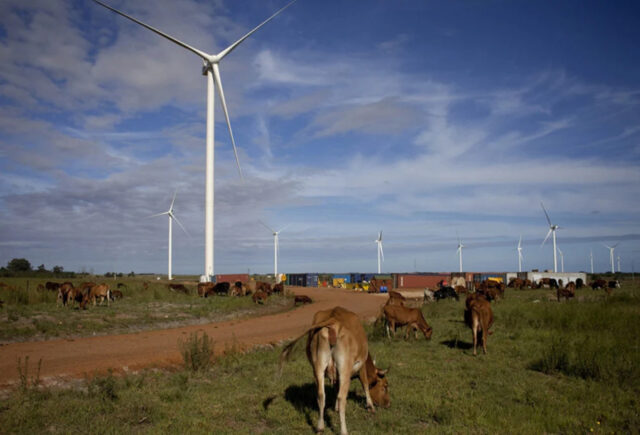The outcome of the COP15 biodiversity summit in Montreal didn’t satisfy everyone but investors say it should trigger a rise in funding flows towards nature protection.

In brief
- Deal calls for $200bn a year of public and private funding of biodiversity protection initiatives by 2030
- Governments to “ensure” large companies monitor and disclose impacts across supply chains
- Concerns over vagueness and lack of enforceability of targets
The global biodiversity agreement approved on 19 December at the COP15 summit in Montreal has been welcomed by investors as a powerful signal to the financial industry to facilitate greater funding flows into nature protection.
But there are concerns that the targets in the final deal, which isn’t legally binding, are not specific or ambitious enough to galvanise the urgent action needed to reverse biodiversity loss.
Delegates from almost 200 countries agreed – after last-minute wrangling – to protect 30% of the world’s land and oceans and restore 30% of degraded ecosystems by 2030.
The deal proposes that $20bn a year in international finance flows from developed to developing countries for biodiversity protection should be mobilised by 2025, rising to $30bn a year by 2030. The text also proposes that countries should be allocating $200bn annually from both public and private sectors for biodiversity initiatives by 2030. It also says subsidies benefiting environmentally harmful activities must be slashed, and acknowledges the crucial role that indigenous people will need to play in implementing biodiversity measures.
Canada’s environment minister Steven Guilbeault, who hosted the Montreal meeting, said the agreement ranked alongside the Paris climate change agreement of 2015 in terms of its historical significance.
‘Catchy’ targets
Investors keen to see a unified approach to biodiversity reporting and funding saw the deal as a vital, if imperfect, springboard for greater action.
Stephanie Pfeifer, CEO of Institutional Investors Group on Climate Change (IIGCC) said the international commitment would provide support for its members and partners “to leverage their knowledge and expertise, creating new pathways and indicators of success and mobilising the wider investment community to help slow and reverse nature loss”.
However, the agreement lacks bite in terms of driving action at a company level, according to Arjan Ruijs, senior responsible investment officer, at Dutch-based asset manager Actiam.
He told Impact Investor that while the headline 30% targets were “catchy”, the agreement puts an emphasis on government action and that it failed to stress clearly enough the role companies needed to play in achieving a number of biodiversity targets.
“The targets do show the importance of mitigating the drivers causing biodiversity loss – land use, overexploitation, climate change, pollution and invasive species – but the focus on nature protection does not clearly show the urgency for companies to take action.” he said.
Investors’ eyes were drawn in particular to Target 15 in the agreement, which requires governments to “ensure” that large and transnational companies “regularly monitor, assess, and transparently disclose their risks, dependencies and impacts on biodiversity” across their operations, supply and value chains and portfolios.
That ought to provide a basis for more accurate and broadly based reporting of biodiversity impacts by companies. Widening the parameters of impact measurement to include company supply chains should also help shine a light on currently little recorded biodiversity impacts – notably deforestation – by suppliers to multinational firms.
The IIGCC said it represented “an important and much-needed policy signal to the real economy” for investors already mobilising efforts on the topic.
But there was disappointment for delegates and investors expecting the COP15 agreement to make such reporting mandatory, which had seemed a possibility in the run up to the conference. The request in the final text for governments to “ensure” Target 15 is met is seen as giving them more wiggle room in the speed and extent of implementation. France’s ecology transition minister, Christophe Bechu, who pushed for mandatory reporting, said a compromise had been necessary to get the deal ratified.
However, there is optimism the deal will still prompt progress on biodiversity reporting.
Actiam’s Ruijs said it was encouraging that the topic is now getting more attention beyond Europe, even if the agreement’s wording could have been stronger.
“To have a level playing field, I would have supported mandatory reporting, but this current formulation is a good start. If more companies start to see the risks caused by global biodiversity loss, not only in their own processes but especially in their value chains, I would assume that they will start to act. Similarly for financial institutions, the risks caused by biodiversity loss are becoming increasingly visible, which will trigger them to better consider those risks,” he said.
COP15 built on progress at November’s COP27 climate change conference in Egypt, where the importance of nature-based solutions in meeting climate goals was recognised, notably with regard to voluntary carbon markets and curbing deforestation.
UK-based investment bank Schroders said nature-based solutions were among the most cost-effective carbon reduction and removal mechanisms available.
“[The COP15 agreement] should send a powerful signal to the corporate and financial industry to continue efforts to measure and price nature-related risks. Initiatives such as the Taskforce for Nature-Related Financial Disclosures will play an important role in further catalysing and standardising this disclosure as it reaches its final iteration next year,” Schroders said.
More action needed
Nevertheless, there is recognition that a long hard road lies ahead if the ambitions in the COP15 agreement are to be realised. The uneven response to measures called for in the Paris climate change accord has underscored the difficulty in implementing any global environmental agreement.
The 23 targets agreed at COP15 replaced a previous set of 20 targets agreed at a 2010 biodiversity conference in Aichi, Japan that were supposed to provide a blueprint for action in the period to 2020. None of those targets were met.
“While the COP15 agreement is an important step forward, more action is needed, especially by countries… And as the deal is not legally binding, it raises concerns about the implementation,” Dutch-based impact investor Triodos Impact Management said.
Triodos called on governments to make all targets for 2030 more specific and “more concretely address how unsustainable production and consumption patterns should be tackled as underlying drivers of biodiversity loss”.
The lack of a ratchet mechanism, which would oblige countries to increase action if targets are not met, also remains a major concern, given the need to mobilise finance for biodiversity measures urgently.
As environmental group Greenpeace put it in its response to the COP15 outcome: “The often fought over question of finance is still not answered, with commitments made not yet sufficient to bridge the biodiversity finance gap. To save biodiversity, finance will not only be a question of how much, but how fast.”





